
Cruis'n Exotica is a 1999 racing video game developed for arcades by Midway Games. The game is a sequel to Cruis'n World and is the third entry in the Cruis'n series.

TrickStyle is a sports video game developed by Criterion Games and published by Acclaim Entertainment for the Dreamcast and Microsoft Windows. Set in the future, the player takes part in stunt-filled hoverboard races through London, Tokyo, and Manhattan, or inside a massive arena called the Velodrome. AirBlade by Criterion and Namco is a spiritual successor. The game received mixed reviews from critics, who praised its graphics and physics, but criticized its gameplay, animations and sound.
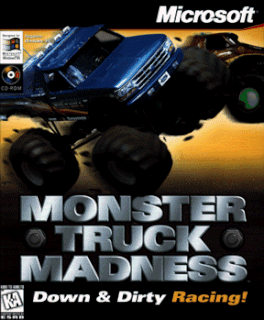
Monster Truck Madness is a racing video game developed by Terminal Reality and published by Microsoft. It was released in North America on August 31, 1996. The game has twelve monster trucks and tasks the player with beating computer opponents. Checkpoints, multiple hidden shortcuts, and interactable objects commonly appear in the tracks. In the garage, the player modifies the truck to account for terrain surfaces. Online multiplayer is accessed with a modem, a local area network (LAN), or TCP/IP.
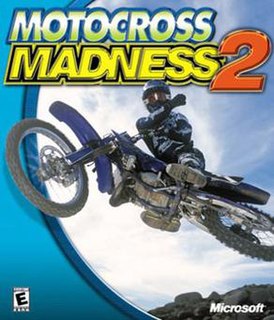
Motocross Madness 2 is a motocross racing video game that was developed by Rainbow Studios and published by Microsoft Games.
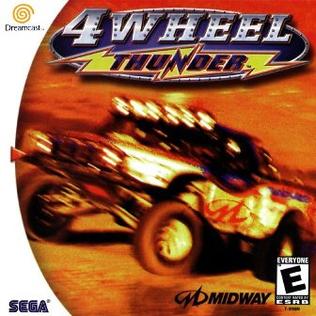
4 Wheel Thunder is a racing game developed by Kalisto Entertainment and published by Midway Games. While the game had been in development for some time prior as a separate title, it was eventually decided to rebrand the game into Midway's Thunder series.

South Park Rally is a 2000 kart-style racing video game based on the American animated sitcom South Park published by Acclaim Entertainment and released for the PlayStation, Microsoft Windows, Nintendo 64, and Dreamcast. Gameplay follows the player in a competitive racing championship set in the fictional town of South Park. Players are given the options for multiplayer, arcade, or championship modes, but only the championship unlocks extra features. Competition begins in South Park's 1st Rally, a circuit race around four checkpoints in the downtown area of South Park. Races get gradually more diverse, with more locations, racers, and elements added as the game progresses.

Cruis'n Velocity is a racing game and the fourth game in the Cruis'n series. The game was developed by Graphic State and released by Midway for the Game Boy Advance in 2001. It is the only game in the series not to be preceded by an arcade release and features slightly different gameplay from its predecessors. The game uses the same engine as Dark Arena, a first-person shooter game also developed by Graphic State, to achieve a pseudo-3D effect. This approach garnered the game mixed reviews.
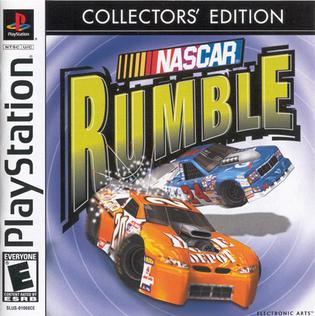
NASCAR Rumble is a racing video game created by Electronic Arts for the PlayStation. Players race through 18 different courses set in six different areas collecting powerups to aid them. The game is a departure from many NASCAR games, as it is an arcade racer featuring various tracks and Mario Kart-esque powerups. A non-NASCAR licensed sequel was made for the PlayStation 2, called Rumble Racing.

NASCAR Arcade, initially known as NASCAR Rubbin' Racing outside North America, is a 2000 racing arcade game developed by Sega Rosso and released by Sega. It was produced at the suggestion of producer Kenji Arai, and the soundtrack was produced by Jun Senoue. The game is based on NASCAR, and carries an official license with permission from Electronic Arts, which permitted Sega to develop the game as a coin-op only title.

F1 2000 is a racing video game developed by Visual Science for the PlayStation version and Image Space Incorporated for the Microsoft Windows version and published by EA Sports for PlayStation and Microsoft Windows. It is based on the 2000 Formula One season. F1 2000 was the last Visual Science F1 game to appear on the PlayStation. With an official FIA Formula One license, it includes the full 2000 World Championship season, including the new Indianapolis Motor Speedway and the Jaguar Racing team.

Ford Racing is a racing video game published by Empire Interactive for Windows and the PlayStation video game console. The computer version was developed by Elite Systems and released on November 2, 2000, while the PlayStation version was developed by Toolbox Design and released on January 29, 2001.

San Francisco Rush: Extreme Racing is a video game developed and published by Atari Games. This game was first released in arcades in 1996 and was ported to Nintendo 64 in 1997 and the PlayStation in 1998. San Francisco Rush: Extreme Racing is the first game in the Rush series.
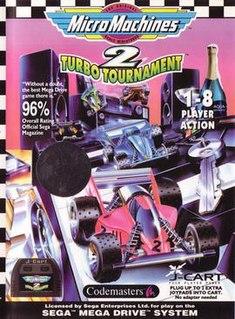
Micro Machines 2: Turbo Tournament is a 1994 racing video game developed by Supersonic Software and published by Codemasters for the Sega Mega Drive. The sequel to Micro Machines, the game is themed around Galoob's Micro Machines toys, and players race around environments in miniature toy vehicles. Micro Machines 2: Turbo Tournament adds new vehicles and game modes, and the Mega Drive version was released on J-Cart, enabling up to eight players without a multitap.

The Dukes of Hazzard II: Daisy Dukes It Out is a racing video game developed by Sinister Games and published by SouthPeak Interactive in North America and Ubi Soft in Europe for the PlayStation in 2000. It is based on the television series The Dukes of Hazzard, which aired from 1979 to 1985; and is a sequel to the 1999 racing video game The Dukes of Hazzard: Racing for Home, also developed by Sinister Games.

Hot Wheels Micro Racers is a racing video game developed by Unique Development Studios (UDS) and published by Mattel Interactive for Microsoft Windows. The game is based on the Hot Wheels toyline, and was unveiled at the American International Toy Fair in February 2000, as a competitor to Micro Machines. Hot Wheels Micro Racers was released on April 28, 2000, and came packaged with a free Hot Wheels car and poster.

Micro Machines is a racing video game developed by Codemasters and originally published by Camerica for the Nintendo Entertainment System (NES) in 1991. Themed around Galoob's Micro Machines toys, players race in miniaturised toy vehicles around various environments. The game is the first installment in the Micro Machines video game series.

Beetle Crazy Cup, released in North America as Beetle Buggin', is a 2000 racing video game developed by Xpiral and published by Infogrames for Microsoft Windows. The game features vehicles by Volkswagen as part of a licensing deal between Infogrames and the automotive company.

Off Road is a 2008 racing video game developed by Razorworks and published by Xplosiv. It is the seventh and final game of the Ford Racing series. It is also the only game in the series to feature vehicles by Land Rover, which was owned by Ford Motor Company at the time. The game was released for the personal computer (PC), PlayStation 2 (PS2), PlayStation Portable (PSP), and the Nintendo Wii. The game received mostly negative reviews.

Ford Mustang: The Legend Lives is a racing video game developed by Eutechnyx and published by 2K Games for the PlayStation 2 (PS2) and Xbox. It is part of the Ford Racing series, following Ford Racing 3. The game was released in the United States on April 19, 2005, and received mixed reviews. This is the first Ford Racing game to not be released on PC.

Innova Disc Golf is a sports video game developed by Sundial Interactive and published by WizardWorks for Innova Discs. It was released for Microsoft Windows on April 12, 2000.




















